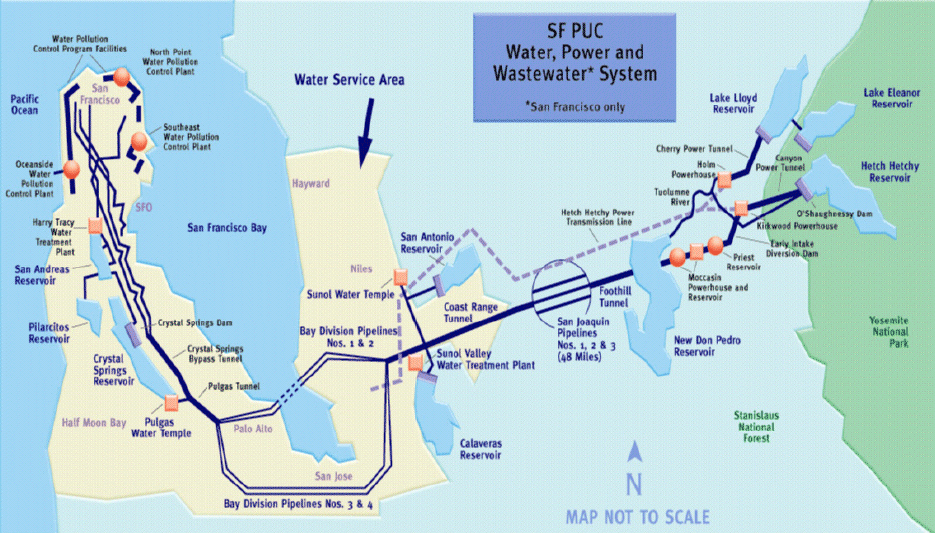San Francisco CA
The city of San Francisco draws most of its raw water from the Hetch Hetchy Reservoir, a high-quality unfiltered supply. The remaining portion (~15%) comes from the Alameda watersheds (Alameda and Santa Clara Counties) and the San Francisco peninusular watersheds (San Mateo County). The former are treated at the Sunol WTP and the latter at the Harry Tracy WTP. A very small amount (<1%) of water comes from the Sunol wells. All water is eventually treated to carry a chloramine residual. SFPUC also supplies some of the water used in South Bay and East Bay areas.
Public Resources
- Compliance Data
- NOMs Data
Consumer Confidence Reports: 2011
Source Water Assessment Program Report
Disinfection Byproducts
Secure UMass Research Site
System Summary Documentation for WRF 4242
Sampling Results for WRF 4242
- Tracy Plant: short article
- SUNOL Schematic
- San Andreas WTP
- PUC Service Area
Plant and System Data
Some Publications in the open literature
| Citation | Notes | Abstract |
|---|---|---|
| Wilczak, A., D.R. Hokanson, R. Trussell, M. Boozarpour, and A.F. Degraca. 2010. Water conditioning for LCR compliance and control of metals release in San Francisco's water system. Journal American Water Works Association 102:52-64. | Despite the documented inefficacy of the calcium carbonate approach to corrosion control, adjustment of calcium carbonate remains the dominant corrosion control strategy. Many utilities still significantly increase alkalinity (with limited or no success) or try to operate at much lower pH values than necessary, both as a means of lead and copper control. Consistent high pH is the main variable controlling release of lead and copper at customer taps. The extent to which pH can be raised must be carefully evaluated on the basis of site-specific conditions. The San Francisco Public Utilities Commission (SFPUC) case profiled here demonstrates that maintaining a high pH is a more appropriate corrosion control treatment to comply with the Lead and Copper Rule (LCR) than adjusting the Langelier saturation index or augmenting alkalinity. The combination of water quality and distribution system conditions at SFPUC is such that a switch from free chlorine to chloramine did not affect lead and copper release or LCR compliance.-MPM. | |
| Weintraub, J.M., B. Flannery, D.J. Vugia, L.B. Gelling, J.J. Salerno, M.J. Conroy, V.A. Stevens, C.E. Rose, R.E. Besser, B.S. Fields, and M.R. Moore. 2008. Legionella reduction after conversion to monochloramine for residual disinfection. Journal American Water Works Association 100:129- | ||
| Boozerpour, M., A. Wilczak, A. deGraca, J. Weintraub, S Garrett, 2007. Impact of Chloramine on SF's WQ 3 Years after Conversion, Proc. AWWA ACE | data on DBPs, NDMA, residuals microbials and corrosion products | |
| Wilczak, A., M. Boozerpour, A. deGraca R.R. Trussel et al., 2007. San Francisco's Corrosion Control Treatment for LCR Complaince, Proc. AWWA ACE | ||
| Roberts, M., T. Gillogly, D. Kraska, C. Chiu, J. McHugh, 2006. Remote Dechloramination: SFPUC's Challenges and Solutions for Environmental Protection, AWWA WQTC Proceedings | ||
| Chiu, C., B. Palacios et al. 2005. Preparing for the Chloramine Conversion..." Proc. AWWA ACE | ||
| Cho, J., E. Sebastiani et al. 2005. Chloramine Startup and Optimization..." Proc. AWWA ACE | ||
| Miller, K., E. Ho et al. 2005. Pulgas Dechloramination Facility..." Proc. AWWA ACE | ||
| Wong, A.R., M. Quady et al. 2005. "Monitoring Locations and Sampling Capabilities for DS Reservoirs" Proc. AWWA ACE | ||
| Carlomango, B., A.R. Wong et al. 2005. "Evaluation of Mixing Improvements in DS Reservoirs for Nitrification Control & Prevention" Proc. AWWA ACE | ||
| Boozarpour, M., A. Wilczak, S. Eddyl. 2005. "Water Quality in SF DS One Year after Change from Free Chlorine to Chloramine" Proc. AWWA ACE | ||
| Spanjian, L., T. Winnicker. 2005. "Media, Political... Rebuilding Hetch Hetchy..." Proc. AWWA ACE | ||
| Public Health session at 2005 ACE, #1, #2, #3, #4, #5 |
Other Written Material

